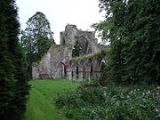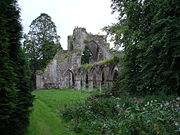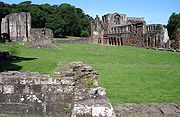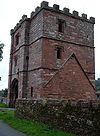
List of monastic houses in Cumbria
Encyclopedia
Cumbria
Cumbria , is a non-metropolitan county in North West England. The county and Cumbria County Council, its local authority, came into existence in 1974 after the passage of the Local Government Act 1972. Cumbria's largest settlement and county town is Carlisle. It consists of six districts, and in...
, England, a modern county including all of the former Cumberland
Cumberland
Cumberland is a historic county of North West England, on the border with Scotland, from the 12th century until 1974. It formed an administrative county from 1889 to 1974 and now forms part of Cumbria....
and Westmorland
Westmorland
Westmorland is an area of North West England and one of the 39 historic counties of England. It formed an administrative county from 1889 to 1974, after which the entirety of the county was absorbed into the new county of Cumbria.-Early history:...
and parts of Lancashire
Lancashire
Lancashire is a non-metropolitan county of historic origin in the North West of England. It takes its name from the city of Lancaster, and is sometimes known as the County of Lancaster. Although Lancaster is still considered to be the county town, Lancashire County Council is based in Preston...
.
| Foundation | Image | Communities & Provenance | Formal Name or Dedication & Alternative Names |
|
|---|---|---|---|---|
| Appleby Whitefriars | Carmelite Friars founded 1281 (c.1290-3) by Lords Vescy, Percy, and Clifford; dissolved 1539 |
|||
| Armathwaite Nunnery Armathwaite Nunnery Armathwaite Nunnery was a Benedictine nunnery in Cumbria, England.It was situated near the junction of the river Croglin with the Eden in the southern angle of the parish of Ainstable, and was first known as the nunnery of Ainstable.-Foundation:... |
Benedictine nuns founded before 1200 (6 January 1089 dubiously purported), endowed by William Rufus William II of England William II , the third son of William I of England, was King of England from 1087 until 1100, with powers over Normandy, and influence in Scotland. He was less successful in extending control into Wales... ; dissolved 1537; granted to William Gryme or Carleil 1552/3 |
(church dedicated to Jesus Christ and the Blessed Virgin Mary) Armethwaite Nunnery 54.7787245°N 2.721439°W |
||
| Calder Abbey Calder Abbey Calder Abbey in Cumbria was a Savigniac monastery founded in 1134 by Ranulph de Gernon, 2nd Earl of Chester and moved to this site following a refoundation in 1142. It became Cistercian in 1148. It is near to the village of Calder Bridge.- History :... |
 |
Savignac monks - from Furness Furness Abbey Furness Abbey, or St. Mary of Furness is a former monastery situated on the outskirts of the English town of Barrow-in-Furness, Cumbria. The abbey dates back to 1123 and was once the second wealthiest and most powerful Cistercian monastery in the country, behind only Fountains Abbey in North... ; founded 10 January 1135-1137 by Ranulf Meschin, first Lord of Cumberland; community released from jurisdiction of Furness to that of Savigny; establishment ruined; transferred to Hood 1138; Savignac monks from Furness Furness Abbey Furness Abbey, or St. Mary of Furness is a former monastery situated on the outskirts of the English town of Barrow-in-Furness, Cumbria. The abbey dates back to 1123 and was once the second wealthiest and most powerful Cistercian monastery in the country, behind only Fountains Abbey in North... ; refounded c.1142-3; Cistercian monks transferred 17 September 1147; dissolved 1536; granted to Thomas Leigh 1538/9; now in private ownership without public access |
Caldre Abbey 54.444053°N 3.465173°W |
|
| Carlisle Cathedral Priory Carlisle Cathedral The Cathedral Church of the Holy and Undivided Trinity, otherwise called Carlisle Cathedral, is the seat of the Anglican Bishop of Carlisle. It is located in Carlisle, in Cumbria, North West England... + |
 |
purported monastery of monks and nuns founded 686 on land granted by Ecgfrith, King of Northumbria Ecgfrith of Northumbria King Ecgfrith was the King of Northumbria from 670 until his death. He ruled over Northumbria when it was at the height of its power, but his reign ended with a disastrous defeat in which he lost his life.-Early life:... ; destroyed by the Danes; rebuilt before 1092 by William Rufus William II of England William II , the third son of William I of England, was King of England from 1087 until 1100, with powers over Normandy, and influence in Scotland. He was less successful in extending control into Wales... and Walter, a Norman priest; secular canons -1092; Augustinian Canons Regular founded 1122 and built by Henry I Henry I of England Henry I was the fourth son of William I of England. He succeeded his elder brother William II as King of England in 1100 and defeated his eldest brother, Robert Curthose, to become Duke of Normandy in 1106... ; dissolved 1540: last prior appointed as first dean of the cathedral; episcopal diocesan cathedral 1133-present |
The Priory Church of the Holy Trinity, Carlisle Carlisle Cathedral The Cathedral Church of the Holy and Undivided Trinity, otherwise called Carlisle Cathedral, is the seat of the Anglican Bishop of Carlisle. It is located in Carlisle, in Cumbria, North West England... The Cathedral Church of The Holy and Undivided Trinity, Carlisle Carlisle Cathedral The Cathedral Church of the Holy and Undivided Trinity, otherwise called Carlisle Cathedral, is the seat of the Anglican Bishop of Carlisle. It is located in Carlisle, in Cumbria, North West England... (1133) Carlilse Priory 54.894713°N 2.938607°W |
|
| Carlisle Blackfriars Carlisle Dominican Friary -References:... |
Dominican Friars (under the Visitation of York) founded (before?) 1233 outside the city walls, but ordered to be demolished for a highway; moved 1237; dissolved 1539 |
|||
| Carlisle Greyfriars Carlisle Franciscan Friary -References:... |
Franciscan Friars Minor, Conventual (under the Custody of Newcastle) founded 1233; church destroyed by fire in 1292 and rebuilt; dissolved 1539 |
|||
| Cartmel Priory Cartmel Priory Cartmel Priory is the parish church of Cartmel, Cumbria . The priory was founded in 1190 by William Marshal, later 1st Earl of Pembroke for the Augustinian Canons and dedicated to Saint Mary the Virgin and Saint Michael. It was first colonised by a Prior and twelve monks from Bradenstoke Priory in... + |
 |
Augustinian Canons Regular founded 1189/94 by William Marshall, Baron of Cartmel and Earl of Pembroke; dissolved 1536/7; granted to John Holcroft 1540/1; church now in parochial use |
Kertmel Priory 54.201157°N 2.952321°W |
|
| Chapel-le-Wood Cell | Premonstratensian Canons cell, dependent on Cockersand Abbey Cockersand Abbey Cockersand Abbey is a former abbey near Cockerham in the City of Lancaster district of Lancashire, England. It was founded before 1184 as the Hospital of St Mary on the marsh belonging to Leicester Abbey. It was refounded as a Premonstratensian priory and subsequently elevated to an abbey in 1192... |
|||
| Conishead Priory Conishead Priory Conishead Priory is a large Gothic Revival building on the Furness peninsula near Ulverston in Cumbria. The priory's name translates literally as 'King's Hill Priory'.-History of the site:... ^, Ulverestoredon |
 |
originally a hospital Hospital A hospital is a health care institution providing patient treatment by specialized staff and equipment. Hospitals often, but not always, provide for inpatient care or longer-term patient stays.... 1160; Augustinian Canons Regular founded 1188 by Gamel de Pennington (or William de Lancaster II); still occupied by canons at 16 October 1536; country house named 'Conishead Priory' built on site: and currently the home of the Buddhist Manjushri Kadampa Meditation Centre |
The Priory Church of the Blessed Virgin Mary, Conishead Conishead Priory Conishead Priory is a large Gothic Revival building on the Furness peninsula near Ulverston in Cumbria. The priory's name translates literally as 'King's Hill Priory'.-History of the site:... Conisheved Priory 54.1731427°N 3.0679321°W |
|
| Dacre Abbey | monks founded before 731; destroyed c.875 by Vikings; refounded before 926; Parish Church of St Andrew built to the south of the site |
|||
| Furness Abbey Furness Abbey Furness Abbey, or St. Mary of Furness is a former monastery situated on the outskirts of the English town of Barrow-in-Furness, Cumbria. The abbey dates back to 1123 and was once the second wealthiest and most powerful Cistercian monastery in the country, behind only Fountains Abbey in North... |
 |
Savignac monks (founded 1124 at Tulkeith by Stephen, Count of Boulogne Stephen, King of England Stephen , often referred to as Stephen of Blois , was a grandson of William the Conqueror. He was King of England from 1135 to his death, and also the Count of Boulogne by right of his wife. Stephen's reign was marked by the Anarchy, a civil war with his cousin and rival, the Empress Matilda... ); transferred from Tulkeith 1126 (1124-7); Cistercian monks transferred 17 September 1147; dissolved 1537; granted to Thomas Cromwell; (EH English Heritage English Heritage . is an executive non-departmental public body of the British Government sponsored by the Department for Culture, Media and Sport... ) |
Furnes Abbey 54.135513°N 3.198145°W |
|
| Hawkshead Grange | Cistercian monks grange of Furness; 17thC Hawkshead Old Hall incorporates remains of grange; currently in use as a farmhouse |
|||
| Holmcultram Abbey Holmcultram Abbey Holmcultram Abbey was a Cistercian monastery founded in 1150 in what is now the village of Abbeytown in Cumbria in England but at the time of foundation was in territory in the possession of David I of Scotland, who together with his son, Henry, founded it in 1150... +, Abbeytown |
 |
Cistercian monks - from Melrose founded 1150 by Henry, son of David, King of Scotland David I of Scotland David I or Dabíd mac Maíl Choluim was a 12th-century ruler who was Prince of the Cumbrians and later King of the Scots... ; dissolved 1538; church in parochial use until destroyed in an arson attack 9 June 2006; roofless boarded-up shell remains; restoration awaited |
Holm Cultram Abbey; Holme Cultram Abbey 54.8453699°N 3.2830641°W |
|
| Holme Eden Abbey Holme Eden Abbey -References:... |
Benedictine nuns removed from Fort Augustus Fort Augustus Fort Augustus is a settlement in the Scottish Highlands, at the south west end of Loch Ness. The village has a population of around 646 ; its economy is heavily reliant on tourism.... 1921; dissolved 1983; formerly Holme Eden Hall; altered for use as a nursing home |
Priory of Saint Scholastica 54.904928°N 2.825383°W |
||
| Kirkby Lonsdale | Benedictine monks manor of St Mary's Abbey, York - incorrectly asserted to have been a cell |
|||
| Kirkby Stephen | Benedictine monks estate of St Mary's Abbey, York - incorrectly asserted to have been a cell |
|||
| Lanercost Priory Lanercost Priory Lanercost Priory was founded by Robert de Vaux between 1165 and 1174, the most likely date being 1169, to house Augustinian Canons. It is situated at the village of Lanercost, Cumbria, England, within sight of Naworth Castle, with which it long had close connections.It is now open to the public and... + |
 |
Augustinian Canons Regular - possibly from Pentney Priory founded c.1166 (or 1169) by Robert de Villibus, Lord of Gilleisland; dissolved 1537; granted to Thomas Lord Dacre part converted into private house named 'Dacre Hall' church now in parochial use (EH English Heritage English Heritage . is an executive non-departmental public body of the British Government sponsored by the Department for Culture, Media and Sport... ) |
The Priory Church of Saint Mary Magdalene, Lanercost Lanercost Lanercost is a village in the northern part of Cumbria, England. The settlement is in the civil parish of Burtholme, in the City of Carlisle local government district. Lanercost is known for the presence of Lanercost Priory and its proximity to Hadrian's Wall.-History:Lanercost Priory was founded... 54.96587°N 2.695513°W |
|
| Nunnery near Kirkoswald | Benedictine nuns house named 'Nunnery House' built on site |
|||
| Penrith Austin Friars Penrith Friary -References:... |
Augustinian Friars (under the Limit of York) founded c.1291; dissolved 1539; house named 'The Friarage' built on site 1717 |
|||
| Preston Patrick ?Abbey | Premonstratensian Canons founded before 1192(?); transferred Shap, infra, before 1201; Challons Hall built on or near site |
The Abbey Church of Saint Mary Magdelene, Preston Patrick Preston Abbey 54.2406446°N 2.7074111°W (possible) |
||
| Ravenstonedale Priory Ravenstonedale Priory Ravenstonedale Priory was a Gilbertine priory in Cumbria, England. It was founded in the reign of Henry II, when Torphin, son of Robert, son of Copsus, assigned the manor and advowson of Ravenstonedale to Watton Priory in Yorkshire. It was supposed to house a master and three canons.-The... |
Gilbertine Canons founded before c.1200; 1539(?); Parish Church of St Oswald built immediately to the south of the site |
Ravenstonedale Cell 54.43312°N 2.429481°W |
||
| St Bees Priory St Bees Priory St Bees Priory is the parish church of St Bees, Cumbria. The Benedictine priory was founded by William le Meschin, Lord of Egremont on an earlier religious site, and was dedicated by Archbishop Thurstan of York sometime between 1120 and 1135... + |
 |
founded after 850 by Bega - possible brief existence, though more likely an anchorites cell; Benedictine monks daughter of St Mary's Abbey, York St Mary's Abbey, York The Abbey of St Mary in York, once the richest abbey in the north of England, is a ruined Benedictine abbey that lies in what are now the Yorkshire Museum Gardens, on a steeply sloping site to the west of York Minster. The original abbey on the site was founded in 1055 and dedicated to Saint Olave... ; founded c.1120 on site of earlier church (c.900?); dissolved 1539; granted to Sir Thomas Challoner 1553/4; church now in parochial use |
The Priory Church of SS Mary and Bega, Saint Bees St Bees St Bees is a village and civil parish in the Copeland district of Cumbria, in the North of England, about five miles west southwest of Whitehaven. The parish had a population of 1,717 according to the 2001 census. Within the parish is St... , Saint Bees Priory St Bees Priory St Bees Priory is the parish church of St Bees, Cumbria. The Benedictine priory was founded by William le Meschin, Lord of Egremont on an earlier religious site, and was dedicated by Archbishop Thurstan of York sometime between 1120 and 1135... St Bee's Priory 54.493913°N 3.593634°W |
|
| Seaton Priory Seaton Priory Originally called the nunnery of Lekeley from the name of the land it was built upon, the former nunnery of Seaton is to the north of the parish of Bootle, Cumbria, England.-Early life:... |
 |
Benedictine nuns daughter of Nunburnholme; founded c.1190-1200 by Henry Kirby; independent after 1313; dissolved 1540; granted to Hugh Askue 1541/2; site now occupied by farmhouse named 'Seaton Hall' |
Nunnery of Leakly, in Seaton; Seton Priory; Lekeley Priory 54.297187°N 3.372929°W |
|
| Shap Abbey Shap Abbey Shap Abbey was a monastic religious house of the Premonstratensian order on the western bank of the River Lowther in the civil parish of Shap Rural, around from the village of Shap, in the Eden District of Cumbria, England... |
 |
Premonstratensian Canons daughter of Cockersand; founded before 1192(?) at Preston Patrick, infra, transferred 1201 (1199), built (in the reign of Henry II) by Thomas Fitz Gospatrick; dissolved 1540; granted to Thomas Lord Wharton 1544/5 (EH English Heritage English Heritage . is an executive non-departmental public body of the British Government sponsored by the Department for Culture, Media and Sport... ) |
Hepp Abbey 54.530233°N 2.699901°W |
|
| Wetheral Priory Wetheral Priory Gatehouse Wetheral Priory Gatehouse is almost all that remains of the Benedictine Wetheral Priory in Wetheral, Cumbria. Wetheral Priory, was founded in 1106 from its motherhouse of St. Mary's Abbey, York. The gatehouse is virtually the only standing remnant of the much grander Priory buildings, and was the... |
 |
Benedictine monks - from St Mary's Abbey, York founded 1106 by Ranulph Meschin, Earl of Cumberland; dependent on York; dissolved 20 October 1538; granted 1541/2 |
The Priory Church of Saint Constantine The Priory Church of the Holy Trinity, Saint Mary and Saint Constantine Wetherall Priory 54.879306°N 2.829993°W |
|

